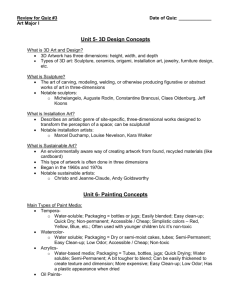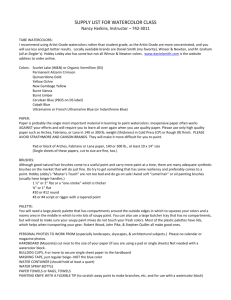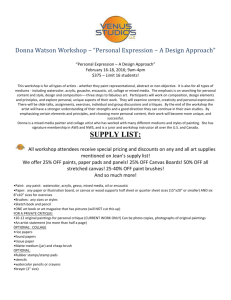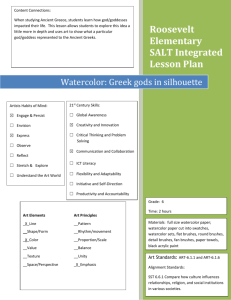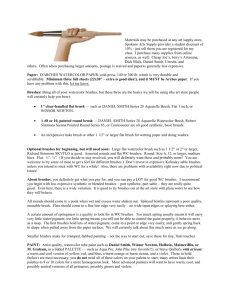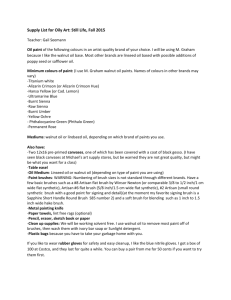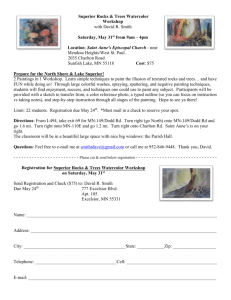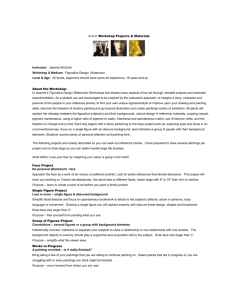Link to Watercolor powerpoint for vocabulary terms for upcoming
advertisement
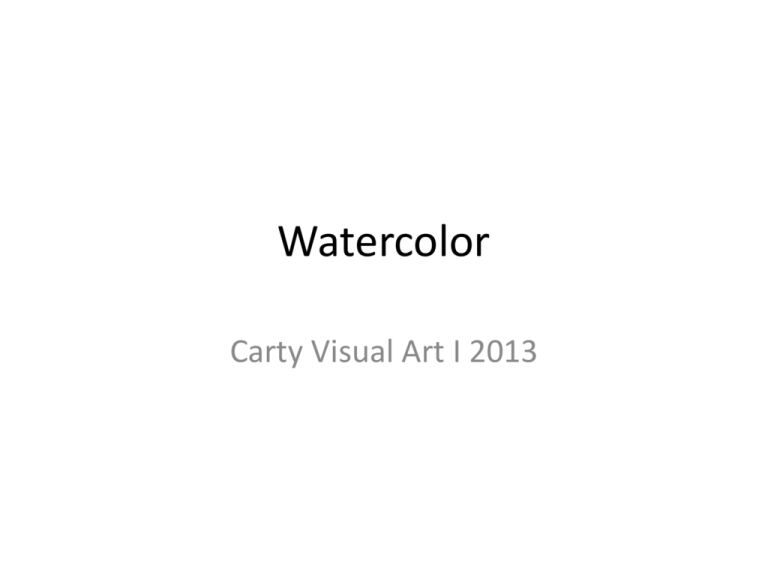
Watercolor Carty Visual Art I 2013 Terms • Transparent: can be seen through- allows the penetration of light • Opaque: cannot be seen through- prohibits the penetration of light Terms continued • Charged Brush: brush is holding full capacity of paint- strokes look juicy • Dry Brush: brush has been wiped repeatedly leaving only small amount of paint- strokes look streaked and dry Techniques • • • • Wet-on-wet: wet paper, charged brush Wet-on-dry: dry paper, charged brush Dry-on-wet: wet paper, dry brush Dry-on-dry: dry paper, dry brush Resists • Resists are used to preserve the white of the paper- they are substances which resist the paint and cause it to not adhere to the painting surface Types of Resists • • • • • • Wax paper Parafin White wax crayon or candle Masking tape Rubber cement Maskoid or other commercial resist product Parts of a brush Types and Shapes of Brushes • Flat: bristle, hair, or nylon – Flat end (chisel point) – Long belly – Flay ferrule Types and Shapes of Brushes • Bright – Flat end – Short belly – Flat ferrule Types and Shapes of Brushes • Filberts: bristle – Oval point – Flat ferrule Types and Shapes of Brushes • Oval wash (mop): hair – Oval point – Flattened ferrule Types and Shapes of Brushes • Rounds: bristle, hair, nylon – Pointed tip – Round ferrule Types and Shapes of Brushes • Fan blenders: bristle (and hair) – Fan shaped – Rounded, flattened heel on ferrule Types and Shapes of Brushes • Hake: Japanese wash brush, soft hair – Slightly fanned – Stitching to hold hair – No ferrule Types and Shapes of Brushes • Lettering brush – Flat point – Very long hair Types and Shapes of Brushes • Dagger: (bristle), hair – Dagger or sword type point – Very long hair – Round ferrule Types and Shapes of Brushes • Hardware utility brush: bristle or nylon (large washes) – Flat – Short handle Composition of Brushes • Bristle: stiff, hog’s hair, “boar” • Nylon: plastic, synthetic • Hair – Red sable: the best, actually made from hair of the Kolinsky or Tartar Martin from Siberia – Sabeline: dyed ox hair – Camel: squirrel hair Sizes of Brushes • Round Brushes- “0000” smallest, 12 is usually largest available • Flats and Brights- ¼ smallest, 1 usually largest (occasionally up to 2) Paper • Basic Composition – Rag: ph balanced, long lasting, highest quality, often hand made – Sulfite: wood pulp, non ph balance leading to decomposition, yellowing, brittleness, much less expensive, machine made Parts of Paper Weight of Paper • Determined by “ream weight” or weight of 500 sheets of that paper in standard size – Ex. 350 lb. paper means that 500 sheets of that paper weigh 350 lbs – Standard weighs run 80 to 400 pounds – In watercolor, it is considered best to stretch all but heaviest papers of the aquarium papers – Paper is sized with glue which is usually removed by moistening when watercolor painting. Blotters are made from unsized paper Special Effects • Salt- sprinkled into wet paint causing granulated, textured, starburst effect Special Effects • Sponges (natural are preferable)- can be used to lift or add color, create textured effects Special Effects • Tissue paper- used to lift color Special Effects • Razors, knife blades- used to pick out of lift small areas of color, or scratch out white lines Special Effects • Sticks, pallete knives etc.- used to apply paint of texture Special Effects • Splatter effects- using stiff tooth brush or atomizer Watercolor Paints • Types – Pan colors: pigments are often inferior, less intense (just dyes) – Tube colors: preferable, more versatile, more intense, more permanent Watercolor Paints • Composition: pigment + gum arabic + (glycerin) + water – Gum arabic is the binder – Pigment is the colorant Watercolor Paints • Pigment Sources – Inorganic • Synthetic mineral- chemical • Natural mineral- “earth colors” – Organic • Animal • Vegetable • Synthetic organic colors Watercolor Paints • Pigment Types – Opaque – Transparent – Staining (light) – Non-staining (heavy) Granulation Theory of Watercolor • Stain: fine particles, sink slowly because they are light enough to stay suspended or floatthey spread or diffuse- they will penetrate into pores of paper- create permanent stain – Ex. Thalo Colors Granulation Theory of Watercolor • Semi-Staining: go down less slowly- particles are less fine so they do not penetrate as rapidly into pores of paper Granulation Theory of Watercolor • Non-Staining: particles are heavy and sink faster because they are larger they do not penetrate pores of paper Granulation Theory of Watercolor • Granulation is created by a combination of thick (heavy) with a thin (light) Pigment – Light pigment will diffuse on the damp paper creating a “halo” stain around the heavier pigment – Pigments separate on the paper and to not stay well-blended • Ex. Thalo Blue and Burnt Sienna, or Thalo Green and Vermillion Transparent Pigments • Stains Light Pigments – – – – – – Sap green Brown madder Rose madder Alizarin crimson New gamboge yellow Sepia • Semi-Stains Heavy Pigments – Hooker’s green(light and dark values) – Anthwerp blue – Payne’s Gray – Aureolin yellow – Lemon yellow – Yellow ochre – Burnt Sienna Opaque Pigments • Semi-Staining Light Pigments – – – – – – – – • Cadmium red Cadmium orange Cadmium yellow Raw sienna Naples yellow Indian red Windsor emerald Cadmium scarlet Non-staining Heavy Pigments – – – – – – – – Vermillion Manganese blue Ultramarine blue Cobalt blue Cerulin blue Chromium oxide green Chinese white Ivory black What not to do… • Muddy colors- created by mixing or overlayering heavy opaque colors • Balloons- hard edges created by uneven drying (use a hairdryer!) • Overworking Additional Information • Glazing- applying a wash over dry paint • Different meanings of “pallette” – Surface used for mixing paint – The selection of colors used in a painting – The selection of colors generally used by an artist in his or her work • Paint the essential, paint broadly, paint details last Sequences of Painting • Three approaches to establishing a composition – Paint center of interest first, progress to least important last (difficult to do in watercolor) – Dark to Light: lay in darks first to achieve unity quickly, dangerous but effective – Light to Dark: lay in light values first, progress to darkest last, a safe conventional approach
